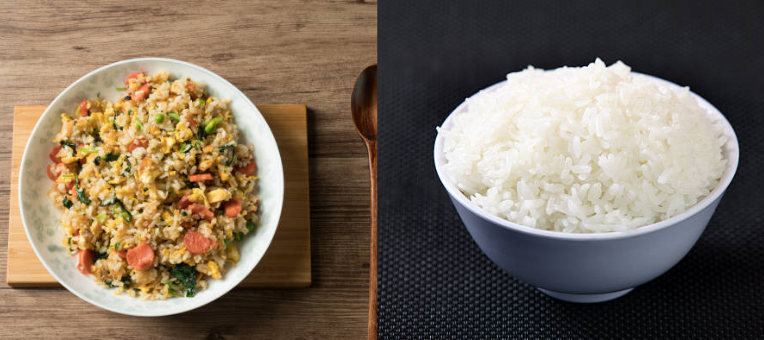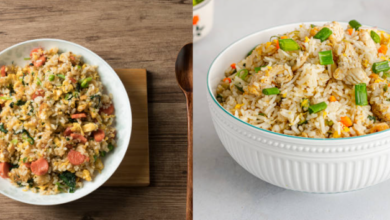Fried Rice Vs. White Rice: Which Is the Better Choice?

What To Know
- This method preserves the natural flavor and texture of the rice, making it a versatile accompaniment to a wide range of dishes.
- White rice, on the other hand, is generally lower in calories, fat, and sodium, making it a healthier option for those seeking a lighter and more controlled diet.
- From the fragrant and colorful nasi goreng of Indonesia to the hearty and flavorful yakimeshi of Japan, fried rice embodies the cultural diversity and culinary heritage of Asia.
The world of rice is vast and diverse, with countless varieties and preparations to explore. Two of the most popular and widely consumed rice dishes are fried rice and white rice. While both are made from the same grain, they offer distinct culinary experiences that cater to different tastes and preferences. This blog post delves into the fascinating world of fried rice vs white rice, comparing their cooking methods, flavors, textures, nutritional values, and cultural significance. Embark on a culinary journey as we uncover the unique characteristics that set these two rice dishes apart.
Cooking Methods: A Clash of Techniques
Fried rice, as the name suggests, is cooked using the frying technique. Typically, cooked rice is tossed in a hot wok or pan with various ingredients such as vegetables, meat, eggs, and sauces. The high heat and constant stirring create a delightful medley of flavors and textures, resulting in a savory and slightly crispy dish.
On the other hand, white rice is cooked through a simpler method known as boiling or steaming. The rice is rinsed and then simmered in water until it reaches a tender and fluffy consistency. This method preserves the natural flavor and texture of the rice, making it a versatile accompaniment to a wide range of dishes.
Flavors: A Symphony of Tastes
Fried rice is renowned for its bold and vibrant flavors. The combination of savory ingredients, such as soy sauce, oyster sauce, and garlic, along with the smoky aroma imparted by the frying process, creates a tantalizing taste sensation. The addition of vegetables, meat, and eggs further enhances the flavor profile, resulting in a dish that is both satisfying and complex.
White rice, on the other hand, possesses a delicate and subtle flavor that allows the natural sweetness of the grain to shine through. Its mild taste makes it an ideal complement to strongly flavored dishes, such as curries, stews, and stir-fries. The simplicity of white rice also allows it to absorb and enhance the flavors of accompanying sauces and condiments.
Textures: A Contrast of Sensations
Fried rice is characterized by its distinct texture, which is a harmonious blend of soft and crispy elements. The rice grains retain a slight chewiness while the vegetables and meat provide a contrasting crunch. The overall texture is often described as “fluffy” or “light,” making it a delightful culinary experience.
White rice, on the other hand, is known for its soft and fluffy texture. The grains are cooked until they are tender and easily separable, creating a smooth and creamy mouthfeel. Its delicate texture makes it a popular choice for dishes that require a neutral and non-intrusive base.
Nutritional Value: A Comparison of Health Benefits
Fried rice and white rice differ in their nutritional profiles, although both provide essential nutrients. Fried rice, due to its combination of ingredients, tends to be higher in calories, fat, and sodium compared to white rice. However, the addition of vegetables and lean protein can enhance its nutritional value, making it a more balanced meal.
White rice, on the other hand, is generally lower in calories, fat, and sodium, making it a healthier option for those seeking a lighter and more controlled diet. It is also a good source of carbohydrates, providing energy and essential vitamins and minerals.
Cultural Significance: A Reflection of Heritage and Tradition
Fried rice holds a prominent place in many Asian cultures, where it is often associated with celebrations, family gatherings, and special occasions. Its versatility and adaptability have made it a staple in numerous cuisines, each with its unique variations and interpretations. From the fragrant and colorful nasi goreng of Indonesia to the hearty and flavorful yakimeshi of Japan, fried rice embodies the cultural diversity and culinary heritage of Asia.
White rice, on the other hand, is deeply ingrained in the culinary traditions of many countries worldwide. In many Asian cultures, white rice is considered a symbol of prosperity, fertility, and abundance. It is often served as a staple food alongside various dishes, providing a foundation for a balanced and nutritious meal.
Which One to Choose: A Matter of Personal Preference
The choice between fried rice and white rice ultimately depends on personal preferences, dietary considerations, and the occasion. Fried rice is an excellent option for those seeking a flavorful and satisfying meal, while white rice provides a versatile and nutritious base for a wide range of dishes.
The “Fried Rice vs White Rice” Conundrum: A Culinary Journey of Discovery
The debate between fried rice and white rice is a testament to the vastness and diversity of the culinary world. Each dish offers a unique experience, catering to different tastes, textures, and nutritional needs. Whether you prefer the bold flavors and textures of fried rice or the delicate simplicity of white rice, exploring both dishes is a culinary journey worth embarking on.
FAQ: Unraveling Common Questions about Fried Rice vs White Rice
#1. Which is healthier, fried rice or white rice?
The healthiness of fried rice and white rice depends on the ingredients used and the cooking method. Fried rice, when prepared with lean protein, vegetables, and minimal oil, can be a nutritious meal. However, traditional fried rice often contains higher levels of fat and sodium. White rice, on the other hand, is generally lower in calories, fat, and sodium, making it a healthier choice for those seeking a lighter and more controlled diet.
#2. Which is more versatile, fried rice or white rice?
Fried rice is a versatile dish that can be adapted to suit various tastes and preferences. It can be prepared with a wide range of ingredients, making it a great way to use up leftovers or create a quick and easy meal. White rice, on the other hand, is a more neutral and versatile accompaniment that can be paired with a wide variety of dishes, from curries and stir-fries to soups and stews.
#3. Which is more popular, fried rice or white rice?
Fried rice and white rice are both popular dishes consumed worldwide. However, white rice is generally more widely consumed due to its versatility, affordability, and cultural significance in many cuisines. Fried rice, on the other hand, is particularly popular in Asian cultures and is often associated with celebrations and special occasions.
